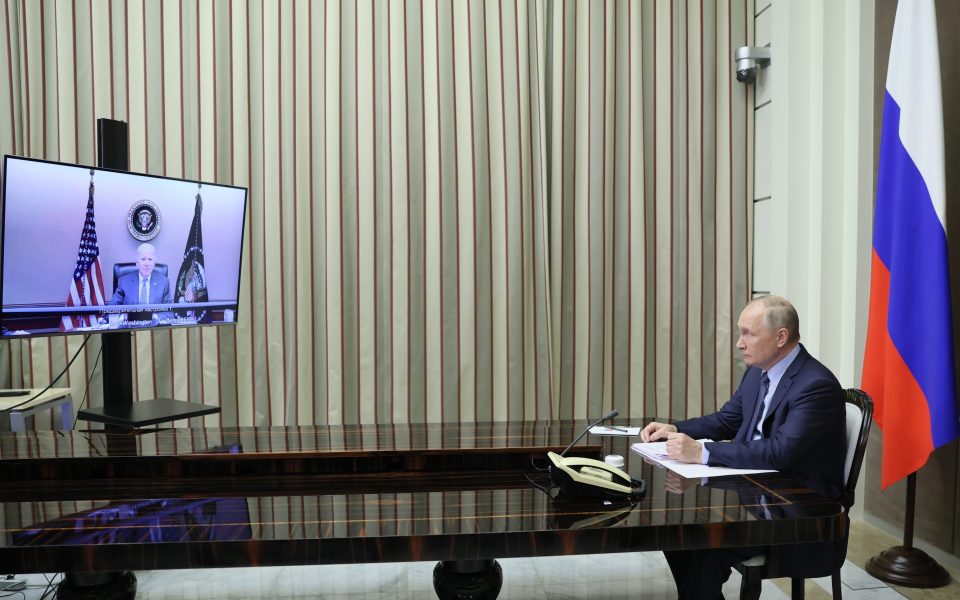Autocracy vs Democracy

If you were a foreign leader hostile to the United States – sitting in, say, Moscow or Beijing – how would you view the United States today?
You would know that it has conducted two largely failed wars, in Afghanistan and Iraq, over the past 20 years and that many Americans have no interest in fighting another faraway conflict with a fuzzy connection to national security.
You would know that the United States itself can’t seem to decide how strongly it feels about democracy, with a former president and his allies around the country mimicking the playbook of autocrats willing to subvert election results.
And you would know that the United States was so politically polarized that many voters and members of Congress might not rally around a president even during a foreign crisis. Americans, after all, have reacted to the pandemic with division and anger, including widespread refusal to take lifesaving vaccines and continuing chaos in schools.
Given all of this, you might not be feeling especially intimidated by the United States, even though it continues to have the world’s largest economy, most important currency and strongest military.
This background helps explain the current tensions in both Ukraine and Taiwan. In each, an authoritarian power is making noises about invading a small nearby democracy, and the United States has sternly warned against any such action. The two authoritarian powers – Russia and China – may ultimately choose to stand down, at least temporarily. But their increasing aggression is a sign of their willingness to defy what their leaders see as a weakened US.
Tuesday, President Joe Biden and President Vladimir Putin of Russia spent two hours in a tense video call, focused largely on Ukraine. Russia recently moved troops toward the border, causing invasion fears.
Putin believes that Ukraine – a country of 44 million people, previously part of the Soviet Union – should be subservient to Russia. The two countries share a 1,200-mile border as well as cultural and linguistic ties (which many Ukrainians think Putin exaggerates).
Instead of aligning itself with Russia, Ukraine has shifted toward the West, including the toppling of a Putin-backed leader in 2014. Ukraine President Volodymyr Zelenskyy has pushed back against Russia’s attempts to expand its influence in his country.
“Putin sees Ukraine developing into a de facto US and NATO military outpost,” says my colleague Michael Crowley, who covers the State Department.
Russia’s amassing of troops along Ukraine’s border is a signal that Putin will consider invasion unless Ukraine backs away from the West. Russia already annexed Ukraine’s Crimean peninsula in a 2014 military operation, although much of the world does not acknowledge it as Russian territory.
Foreign aggression often gives political leaders a chance to rally nationalistic support at home, especially as a distraction from domestic problems. And Russia has domestic problems, like surging COVID cases, stagnant wages and rising prices. Last year, opposition groups held some of the largest anti-Putin marches in years.
Putin may also fear that his sway over Ukraine is weakening, both because of Zelenskyy’s resistance within Ukraine and internal Russian politics. Kadri Liik of the European Council on Foreign Relations says: “Not all members of Russia’s political establishment share Putin’s obsession with the country, or his passionate view that the Ukrainians and Russians are the same people.”
For years, Russian-backed separatists and Ukrainian troops have fought skirmishes along Ukraine’s eastern border (the other hot spot, in addition to the Crimea). The two sides have exchanged fire from machine guns and grenade launchers.
International diplomats worry the skirmishes could offer Putin a pretext for invasion. US intelligence officials say that Russia’s military has developed a war plan in which up to 175,000 troops could pour across Ukraine’s border.
Russia’s tactics are not limited to military force, either. It has waged a war of disinformation, falsely labeling the 2014 revolution a fascist coup and launching cyberattacks against Ukraine’s government, military and power systems.
These tactics, of course, also recall Putin’s interference in the 2016 election to help Donald Trump’s campaign – which Russia has falsely blamed on Ukraine. In a recent Atlantic magazine cover story, Anne Applebaum explains how he and his allies are using disinformation to support an autocrat in Belarus as well.
Even if Russian troops don’t invade, Putin could gain from the confrontation, by intimidating the United States and Western Europe into backing away from Ukraine.
Putin has rejected multilateral diplomacy on Ukraine, insisting on one-on-one conversations with the United States. “He wants a Cold War-style treaty,” Anton Troianovski, The Times’ Moscow bureau chief, says. But Putin’s demands – including a pledge that NATO would stop military cooperation with Ukraine – are probably too big for Biden to be able to meet.
More likely than a treaty is a continued mix of confrontation and diplomacy.
On its own, Ukraine’s military seems overmatched by Russia’s. And a full-scale US military response seems doubtful, given a weariness of foreign wars that Biden and many American voters share.
But Biden still has options. The United States can increase its military support to Ukraine, which has the benefit of making an invasion look more painful for Russia but the risk of inflaming tensions.
Biden can also threaten sanctions on Russia, as he did on the call with Putin on Tuesday, according to Jake Sullivan, the president’s national security adviser. “He told President Putin directly that if Russia further invades Ukraine, the United States and our European allies would respond with strong economic measures,” Sullivan told reporters. Biden also said that the United States would react more strongly than it did to Russia’s 2014 takeover of the Crimean peninsula.
But sanctions might not be enough to deter Putin. Autocracies have endured sanctions in recent years partly with economic aid from other autocracies, including China. It’s one of the realities of a world where autocracy is on the rise.
[This article originally appeared in The New York Times.]






